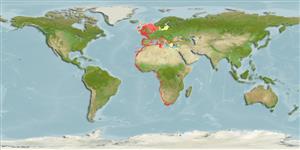Classification / Names
Common names from other countries
Main reference
Size / Weight / Age
Max length : 20.0 cm SL male/unsexed; (Ref. 189); common length : 13.5 cm SL male/unsexed; (Ref. 189); max. published weight: 0.00 g; max. reported age: 5 years (Ref. 92145)
Length at first maturity
Lm 9.7, range 9 - 14 cm
Environment
Marine; brackish; pelagic-neritic; oceanodromous (Ref. 51243); depth range 0 - 400 m (Ref. 2683)
Climate / Range
Subtropical, preferred 21°C (Ref. 107945); 62°N - 37°S, 18°W - 42°E (Ref. 54230)
Distribution
Eastern Atlantic: Bergen, Norway to East London, South Africa (perhaps reaching Durban) (Ref. 10000). Also all of Mediterranean, Black and Azov seas, with stray individuals in Suez Canal and Gulf of Suez; also recorded from St. Helena (Ref. 189). Reported from Estonia (Ref. 33247).
Countries | FAO areas | Ecosystems | Occurrences | Introductions
Short description
Dorsal
spines
(total): 0;
Dorsal
soft rays
(total): 16-18;
Anal
spines: 0;
Anal
soft rays: 13 - 15;
Vertebrae: 46 - 47. Snout pointed; maxilla short, tip blunt, reaching almost to front border of pre-operculum, not projecting beyond tip of second supra-maxilla; tip of lower jaw reaching almost to below nostril. Gill rakers present on hind face of third epibranchial. Pseudobranch longer than eye, reaching onto inner face of operculum. A silver stripe along flank, disappearing with age.
IUCN Red List Status (Ref. 115185)
Threat to humans
Harmless
Human uses
Fisheries: highly commercial; bait: usually
Tools
Special reports
Download XML
Internet sources
Estimates of some properties based on models
Phylogenetic diversity index
PD50 = 0.5020 many relatives (e.g. carps) 0.5 - 2.0 few relatives (e.g. lungfishes)
Trophic Level
3.1 ±0.36 se; Based on food items.
Resilience
Medium, minimum population doubling time 1.4 - 4.4 years (K=0.3-1.73; tmax=6; Fec =13,000-503,000)
Vulnerability
Low vulnerability (25 of 100)
Price category
